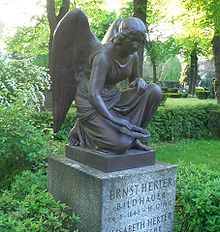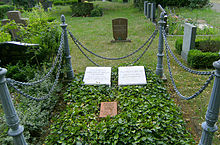Old Twelve Apostles Cemetery
The Old Twelve Apostles Cemetery at Kolonnenstrasse 24-25 in Berlin-Schöneberg is one of the most important burial places in Berlin in terms of art and cultural history. The cemetery is a garden monument because of its picturesque architectural and sculptural elements.
Location and layout



As the first cemetery of the Twelve Apostles Cemetery, the Old Twelve Apostles Cemetery was built in 1864 far outside the then inhabited urban area on land owned by the military treasury. The roughly rectangular cut main area of the cemetery was gradually acquired and put into use until 1879. In 1865/66 the first late classical chapel with its arcades and the mortuary hall were built according to a design by building inspector Gaertner. Both buildings are no longer there today. The cemetery was fully occupied for the first time in 1882. In 1900 a new courtyard building was built in the entrance area.
The design of the Twelve Apostles Cemetery goes back to a design by the famous royal garden inspector Carl David Bouché from 1864. Bouché had been working in the nearby botanical garden (today's Kleistpark ) since 1843 and presumably supervised the execution of the cemetery. From this initial design, the original structure of the complex and the main path network with the lime tree avenues have been preserved to this day. In the meantime the cemetery has been provided with new fortifications and new plantings. Instead of the grave digger's house with its front garden, as well as the chapel and mortuary hall destroyed in 1944, the buildings from 1957 and later redesigns shape the appearance today. Access from Kolonnenstrasse is through a modern residential building.
description
With its representative hereditary burial facilities from the late 19th and early 20th centuries lined up along the surrounding walls, the cemetery still offers an almost closed, artistically designed appearance based on the Italian model of a Campo Santo. This unique degree of preservation is rare compared to other Berlin cemetery complexes from the same period of origin.
What is striking about the hereditary burial grounds in the Old Twelve Apostles Churchyard is the abundance of outstanding artistic designs. Examples of the outstanding personalities buried here are the writer Ernst Wichert , the natural scientist and science historian Ludwig Darmstaedter, the politicians Bernhard von Bülow and Friedrich Naumann , the composers Moritz Jaffé and Robert Radecke and the historian Johann Gustav Droysen . In particular, the remarkable number of important 19th century artists buried in the cemetery, such as the sculptors Reinhold Begas and Ernst Herter , whose graves are decorated with galvanically bronzed figures, point to its high status among Berlin burial sites.
As part of the work of the Foundation for Historical Cemeteries and Cemeteries in Berlin-Brandenburg , monument preservation measures for the repair and conservation of historical graves were carried out in the cemetery between 1996 and 1998 with funds from the German Class Lottery Foundation . To ensure the security and preservation of other important tombs, grave sponsorships are also offered in the Old Twelve Apostles Cemetery.
Graves of famous people
( ± = grave of honor )
- Bertha von Arnswaldt (1850–1919), Salonnière
- Lotte Backes (1901–1990), pianist and composer
- Reinhold Begas ± (1831–1911), sculptor
- Heinrich Bertram ± (1826–1904), educator, local politician and honorary citizen
- Wilhelm Böckmann (1832–1902), architect
- Ludwig Brunow (1843–1913), sculptor (inconspicuous in the family grave)
- Bernhard von Bülow (1849–1929), politician
- Paul Eduard Crodel (1862–1928), painter
- Ludwig Darmstaedter ± (1846–1927), scientist and chemist
- Johann Gustav Droysen ± (1808–1884), historian
- Max Duncker (1811–1886), historian and politician
- Alexander von Falz-Fein ± (1864–1919), naturalist and founder of the zoo
- Friedrich von Falz-Fein ± (1863–1920), large landowner and founder of the zoo
- Ernst Eduard Fürstenau ± (1826–1913), pedagogue and city school councilor, city elder
- Rudolf Genée (1824–1914), writer, theater historian and reciter
- Carl Georg Anton Graeb ± (1816–1884), royal court painter, landscape and architecture painter
- Ernst Ludwig Herrfurth (1830–1900), Prussian Minister of the Interior
- Ernst Herter (1846–1917), sculptor
- Friedrich Kiel (1821–1885), composer, university professor. 1971 moved to Puderbach
- Georg Klauer (1876–1947), President of the Reich Patent Office
- Hermann Knauer (1872–1909), architect ( Neues Schauspielhaus , KaDeWe , Hotel Esplanade )
- Reinhold Koser ± (1852–1914), historian
- Karl Paul Marcus (1854–1932), royal court locksmith
- Friedrich Naumann ± (1860–1919), theologian and social politician
- Robert Radecke ± (1830–1911), composer and conductor
- Franz Reuleaux ± (1829–1905), engineer and professor
- Walter Julius Viktor Schoeller (1880–1965), chemist
- Victor Schröder (1862–1885), wall grave with bronze relief by Carl Schuler
- Friedrich Schröder-Sonnenstern (1892–1982), painter and Berlin original
- Heinrich Spiero (1876–1947), writer
- Hermann Wilhelm Vogel (1834–1898), photo chemist
- Robert Warthmüller (1859–1895), painter
- Heinrich Wefing (1854–1920), sculptor
- Anton von Werner ± (1843–1915), history painter
- Ernst Wichert (1831–1902), writer
See also
Web links
Coordinates: 52 ° 29 ′ 1.2 ″ N , 13 ° 21 ′ 55.6 ″ E

